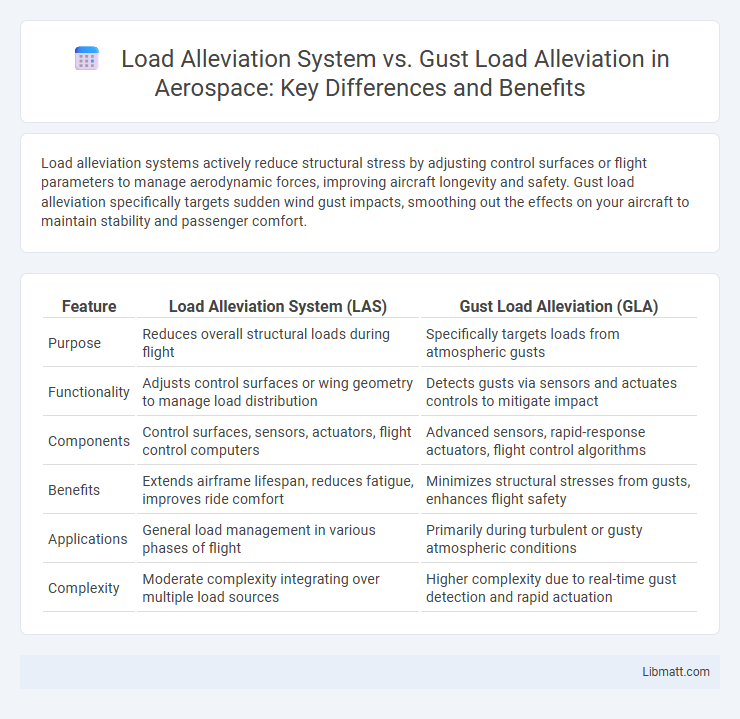Load alleviation systems actively reduce structural stress by adjusting control surfaces or flight parameters to manage aerodynamic forces, improving aircraft longevity and safety. Gust load alleviation specifically targets sudden wind gust impacts, smoothing out the effects on your aircraft to maintain stability and passenger comfort.
Table of Comparison
| Feature | Load Alleviation System (LAS) | Gust Load Alleviation (GLA) |
|---|---|---|
| Purpose | Reduces overall structural loads during flight | Specifically targets loads from atmospheric gusts |
| Functionality | Adjusts control surfaces or wing geometry to manage load distribution | Detects gusts via sensors and actuates controls to mitigate impact |
| Components | Control surfaces, sensors, actuators, flight control computers | Advanced sensors, rapid-response actuators, flight control algorithms |
| Benefits | Extends airframe lifespan, reduces fatigue, improves ride comfort | Minimizes structural stresses from gusts, enhances flight safety |
| Applications | General load management in various phases of flight | Primarily during turbulent or gusty atmospheric conditions |
| Complexity | Moderate complexity integrating over multiple load sources | Higher complexity due to real-time gust detection and rapid actuation |
Introduction to Load Alleviation in Aviation
Load alleviation systems in aviation are designed to reduce structural stress on aircraft by modifying control surfaces in response to dynamic flight conditions. Gust load alleviation specifically targets the impact of sudden atmospheric disturbances, such as turbulence, by actively adjusting wing surfaces to counteract gust forces and maintain stability. Your aircraft's longevity and passenger comfort benefit from these systems by minimizing fatigue loads and improving handling during turbulent flight.
Defining Load Alleviation Systems
Load Alleviation Systems are advanced control technologies designed to reduce structural stress on aircraft by adjusting control surfaces or engine power in response to aerodynamic forces. Gust Load Alleviation specifically targets transient wind gusts to minimize fluctuating loads and improve passenger comfort and structural longevity. Understanding the distinction helps you optimize aircraft performance and safety under varying atmospheric conditions.
What is Gust Load Alleviation?
Gust Load Alleviation is a specialized system designed to reduce the impact of sudden, unexpected wind gusts on aircraft structures by adjusting control surfaces in real-time. Unlike general load alleviation systems that manage overall structural loads during various flight conditions, Gust Load Alleviation specifically targets transient aerodynamic forces caused by turbulent airflow. By minimizing these gust-induced stresses, the system enhances flight safety, improves passenger comfort, and extends the lifespan of your aircraft components.
Key Differences Between Load Alleviation and Gust Load Alleviation
Load alleviation systems broadly reduce structural loads on aircraft by managing various operational stresses, while gust load alleviation specifically targets the reduction of loads caused by atmospheric gusts. Gust load alleviation utilizes sensors and control surfaces to counteract rapid changes in wind velocity, minimizing impact on the airframe. You can optimize aircraft performance and longevity by understanding these distinctions, ensuring precise control strategies tailored to different load scenarios.
Components of Load Alleviation Systems
Load Alleviation Systems primarily consist of sensors, actuators, and control units designed to reduce structural stress on aircraft during turbulence or gusts. Gust Load Alleviation specifically uses accelerometers, pressure sensors, and smart control algorithms to detect and counteract sudden wind gusts, optimizing aerodynamic forces. Your aircraft's performance and safety benefit from the precise interaction of these components, minimizing fatigue loads and enhancing ride comfort.
How Gust Load Alleviation Works
Gust Load Alleviation (GLA) systems reduce structural stress on aircraft by detecting sudden changes in wind velocity and adjusting control surfaces to counteract the impact. Sensors measure gust intensity, allowing real-time aerodynamic modifications that improve ride comfort and extend airframe life. Your aircraft's load alleviation system incorporates this process to maintain stability and enhance safety during turbulent conditions.
Engineering Challenges in Load Management
Load alleviation systems must address complex dynamic forces to protect structures, requiring advanced sensors and real-time control algorithms. Gust load alleviation specifically targets unpredictable wind gusts, demanding rapid response and adaptive mechanisms to maintain stability. Your engineering solutions should prioritize precision and reliability to effectively manage varying load conditions while minimizing structural stress.
Benefits of Advanced Alleviation Technologies
Advanced load alleviation systems enhance aircraft structural integrity by dynamically reducing stress during turbulent conditions, leading to extended airframe lifespan and lower maintenance costs. Gust load alleviation specifically targets rapid wind gusts, improving ride comfort and flight stability, which increases passenger safety and operational efficiency. Your aircraft benefits from integrating both technologies, optimizing performance and minimizing fatigue damage through real-time adaptive control mechanisms.
Implementation in Modern Aircraft Design
Load alleviation systems in modern aircraft design integrate advanced sensors and control surfaces to reduce structural stress during various flight conditions, enhancing durability and passenger comfort. Gust load alleviation specifically targets sudden atmospheric disturbances by dynamically adjusting control elements to counteract turbulence-induced forces. Your aircraft benefits from these systems by achieving optimized performance and extended airframe lifespan through real-time load management.
Future Trends in Load and Gust Alleviation
Future trends in load and gust alleviation emphasize advanced sensor integration and real-time adaptive control algorithms that optimize aircraft structural response during turbulent conditions. Innovations in distributed sensor networks enhance gust detection accuracy, while machine learning models predict and counteract aerodynamic loads more efficiently. Your aircraft's performance and longevity benefit significantly from these cutting-edge systems, which aim to reduce structural fatigue and improve passenger comfort.
load alleviation system vs gust load alleviation Infographic

 libmatt.com
libmatt.com